2012 Maritime Heritage Expedition Log by Etta Karth – July 18, 2012
Maritime Heritage Update
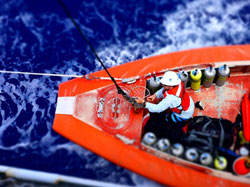
Jason Raupp (PMNM Maritime Heritage, Finders University South Australia) prepares the transit boat, loaded with scuba tanks for the team's many dive operations. Credit: Etta Karth/NOAA
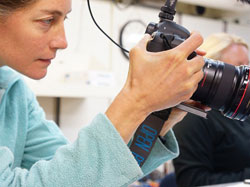
Stephanie Gordon documents a meeting in the dry lab about the Two Brothers shipwreck for a Maritime Heritage documentary she is working on with Open Boat Films. Credit: Etta Karth/NOAA
The Maritime Heritage Team are doing daily multiple dive surveys of previously located maritime heritage sites, and remote sensing surveys to locate other reported and undiscovered shipwrecks at each stopping point of the Hiʻialakai. In French Frigate Shoals, they are surveying the previously located Two Brothers, a Nantucket whaleship and the Churchill, a four-masted schooner, and also searching for the South Seaman whaling shipwreck site and the Daniel Wood. At Pearl and Hermes Reef, they are surveying the Quartette and Pearl and Hermes shipwreck sites, and at Midway, they are surveying various plane wrecks. The team conducts two to four dives daily, ranging from 20-50 minutes each. Some of the sites are an hour and a half away from the main ship, only accessible using small launch boats. The team hopes to locate artifacts using metal detectors, document any new findings, and create visual hand-drawn site plans.
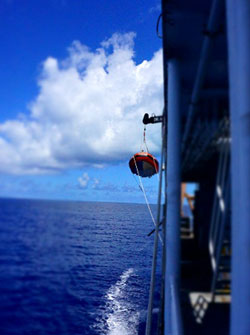
Small boat lowered with a crane off the Hiʻialakai to transit researchers to sites. Credit: Etta Karth/NOAA
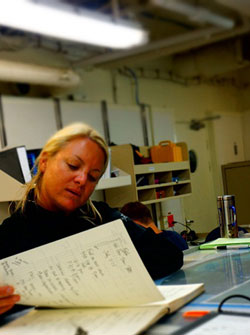
Kelly Gleason reviews previous Maritime Heritage site drawings and notes to prepare for the following day's dive operations. Credit: Etta Karth/NOAA
Team: Kelly Gleason (PMNM Maritime Heritage Lead Scientist), Stephanie Gordon (Open Boat Films Cinematographer), Jason Raupp (Maritime Heritage PhD student at Finders University in South Australia), Bert Ho (National Park Service Submerged Resources Center), Susie Holst (NOAA, NOS), and Kathy Green (NOAA/ONMS).
Apex Predator Tagging and Tracking Update
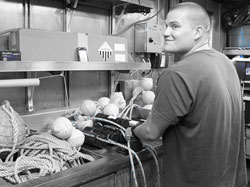
Christian Clark prepares receivers in the wet lab he and the Apex Predator team are replacing throughout the Monument in order to track the newly and formerly tagged apex predators. The previous receivers will be cleaned and their data downloaded and analyzed. Credit: Etta Karth/NOAA
The Apex Predator Tagging and Tracking Team are utilizing fishing gear and bait to capture large predators (specifically sharks, ulua - jacks, and groupers). Once captured, the animals are surgically implanted with small ultrasonic transmitters. The team is seeking to answer the following key questions:
1. Which top predators move across open-ocean between atolls?
2. How extensive are their intra-atoll movements?
3. Do top predators exhibit predictable patterns of movement and habitat use?
Appropriate management options will depend on the answers to these questions. If populations of key species are "tied" to individual atolls or islands, this would have different management implications than if significant numbers of individuals move between atolls or, indeed, move throughout the Hawaiian archipelago.
Click Here for more information.
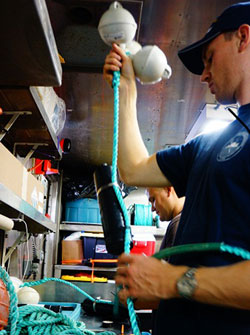
Mark Royer makes a replacement Apex Predator receiver in the wet lab to track newly and formerly tagged sharks, ulua and groupers. The old receivers will be cleaned and their data downloaded and analyzed. Credit: Etta Karth/NOAA
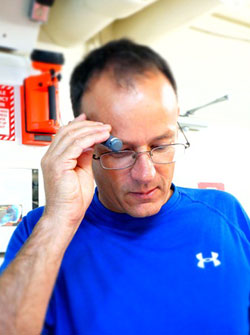
Carl Meyer demonstrates how to hear the transmitter energy waves in the dry lab that come out of the tracking devices he and his team implant in apex predators. The device is subtle but strong, and has proven to collect excellent data on apex predator movements throughout oceanic environments. Credit: Etta Karth/NOAA
Team: Carl Meyer (HIMB PhD Lead Scientist), Mark Royer (HIMB Masters student), and Christian Clark (HIMB Masters student).
